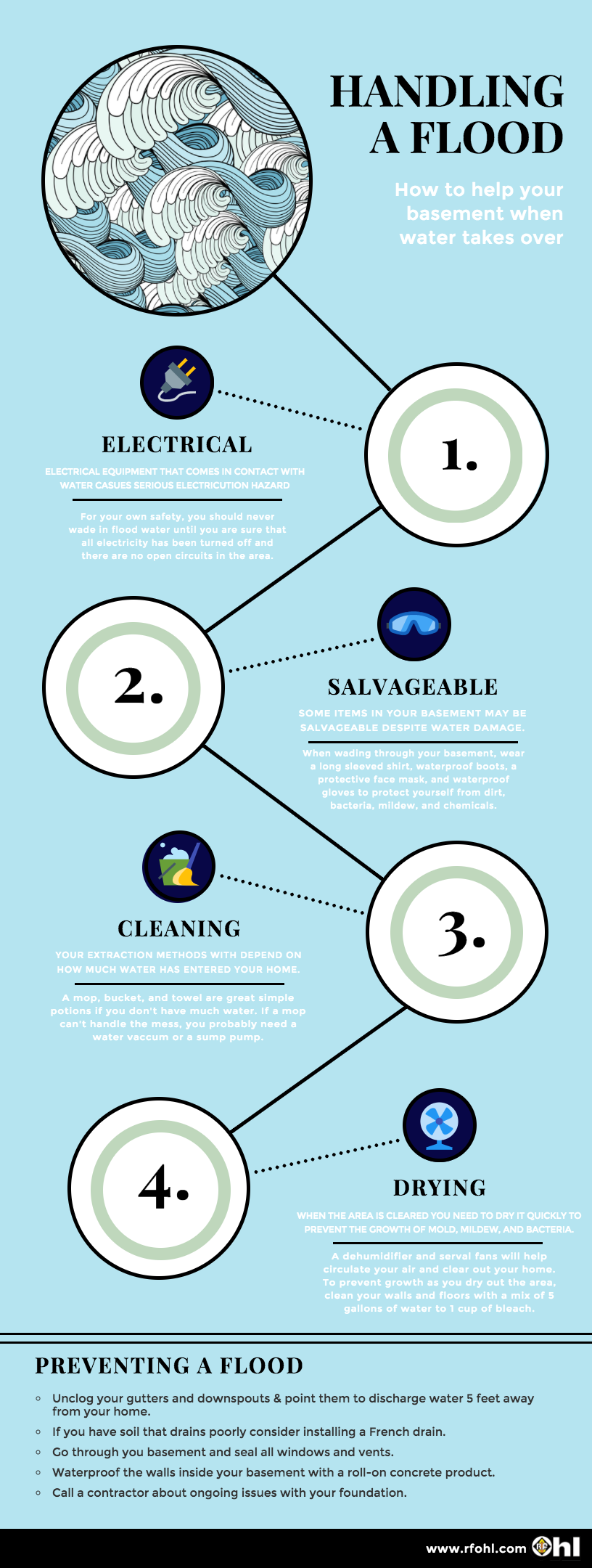Broken Water Heater? Tips on How to Handle a Flood In Your Basement
By nature, water flows downhill to the lowest point it can find. Unfortunately for your home, this makes your basement prone to flooding. Water can flood your home for a plethora of reasons such as large amounts of melting snow, copious rainfall, bursting pipes, damaged foundation, and more. Whichever scenario causes a flood in your basement, it is important to understand how it happened, how to fix the damage and most all, how to prevent it.
There are a multitude of ways water can enter your home. Some problems arise over time. Basements are primarily susceptible to cracks and fissures as your home’s foundation gradually settles and shifts. Even the tiniest of these cracks can let water pour in. Basement windows are another source of potential water damage as their sealants deteriorate. Other problems may happen suddenly. Disruptions such as earthquakes can cause cracks that may not have been previously noticed. Even landscape changes like the removal of a tree can affect your soil’s ability to absorb water.
Plumbing problems can create a variety of both gradual and sudden water issues in your basement. Piping from water heaters, washing machines, and other appliances may freeze in your basement causing sudden bursts of water damage. Other problems such as rusting pipes or water heaters will create erosion and eventually cause leaks.
If any of these scenarios cause a flood in your home, it is important to fix the problem safely. During a flood, any electrical equipment that comes in contact with water creates a serious potential for electrocution. Do not attempt to wade in it until all the electricity has been shut off and you are sure that there are no open circuits in the area. If you cannot reach your breaker box safely you should call an electric utility and have your power turned off at the meter.
Once your electricity is under control, you’ll need to salvage what you can and determine how to get rid of the water. Before you dive in, make sure you wear proper clothing for the job. You should suit up in a long-sleeved shirt, waterproof boots, a protective face mask, and waterproof gloves. This Hazmat level of protection is a necessary precaution as you enter the flood zone. The water that has entered your home could be full of dirt, bacteria, mildew, mold, germs and even chemicals.
When you are ready to get rid of the water, make sure you asses the best extraction methods. If you find yourself with too much water for a mop or towels, you’ll need to upgrade to specialized equipment. A sump pump or a water vacuum are both great options but you should choose wisely between the two depending on your removal needs. A sump pump will require an outlet for the water to be removed. This likely means you will need a long hose attached to the pump that can hang out a window and drain far from your home. With a wet vacuum, you will need to dump the water every few minutes. You can also choose a wet shop vacuum which will hold more water but it will be heavier and more difficult to empty.
Once the water is out of your home, you have to clear out space. This means getting rid of what is damaged beyond repair and displacing salvageable items to dry areas. As you sort through your items, be careful with any electronics. If an electrical appliance has been in contact with water you should consult a professional before using it because it may need to be repaired or replaced. If you have carpeting in your basement, it is best to call a professional carpet cleaning service before you rip the whole thing up. Their services may be able to save you the cost of new flooring.
Now that your basement is finally cleared you will need to move quickly to prevent the growth of mildew, bacteria, and mold. If your heating system was not damaged turning up the temperature will help the drying process. However, if you use heat then make sure your windows are open. The heat will help the water evaporate but if the air can’t escape your basement will become very humid. If you can’t open the windows in your basement due to rain or snow, consider using a dehumidifier. Using fans throughout the area is a great way to circulate air and help the process move quickly. Make sure you place the fans so that they so blow away and out of the room.
While your area is drying out, you’ll need to do some cleaning and sanitizing. Create a mix of 5 gallons of water to 1 cup of bleach. As long as your floor is uncarpeted, use this mixture on the walls and floors.
Now that your flood is finally under control you may want to consider preventive measures for the future. Make sure your gutters and downspouts unclog and pointed to discharge water at least 5 feet away from your home. If you have soil that drains poorly consider installing a French drain around your home. Go through your basement and seal all windows and vents. You may even want to waterproof the walls inside your basement with a roll-on concrete product. If you have ongoing issues with your foundation, call a foundation contractor.

